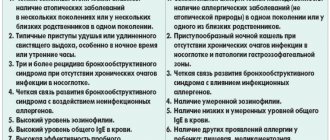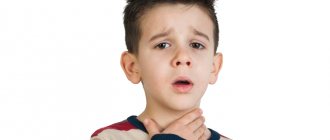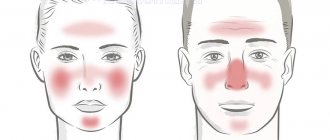- The structure of ENT organs in children
- Physiological features of the cough reflex
- Causes of cough in children
- Does it occur in a healthy person?
- Classification
- What does a severe cough mean?
- What is dry cough
- What to do with a barking cough
- Prevention and treatment of false croup
The structure of ENT organs in children
The human respiratory system has three sections: upper (nose, pharynx), middle (larynx, trachea, bronchi) and lower (alveoli, bronchioles). At birth, the respiratory tract is in the stage of formation, which is associated with the functional characteristics of the breathing of babies. By the age of seven, the development of the respiratory system enters its final stage, after which its size increases.
Children have a narrower lumen of the larynx, and the mucous membrane is thin and tender. The submucosal layer is loose and richly supplied with blood. The cartilage that forms the frame of the respiratory tract is pliable and soft. The above explains the vulnerability of the mucous membrane and the predisposition to easier penetration of infectious and atopic agents into the bloodstream. When inflammation occurs due to swelling, the airways narrow, making it difficult to breathe normally. The glands may secrete excess mucus. During the day, when the child is active, mucus drains well from the respiratory tract, but at night it can irritate the larynx. Separately, it is worth mentioning the reduced production of immunoglobulins and other immunity factors compared to adults.
Physiology of cough
The ability to effectively cough up sputum develops by the age of 4-6 years. Until this age, it, being in the respiratory tract, can interfere with normal breathing. Sputum secretion with normal rheological properties is formed by 5-6 years. Cough medications can be harmful to a young child because, with excess mucus and weakness of the respiratory muscles, they can worsen the cough and cause complications.
Bromhexine for children
The drug bromhexine is actively used in pediatric practice and has various release forms suitable for children: syrup, mixture (solution), low-dose tablets (4 mg).
The effect of bromhexine is based on the drug’s ability to thin mucus and facilitate its removal from the child’s respiratory tract.
Cough syrup for children
syrup is very easy to use, has a fruity taste and children drink it with pleasure. The syrup is prescribed to children from two years of age. This is due to the fact that children under one year old cannot cough on their own and they may experience stagnation of sputum in the bronchi. The accumulation of sputum can lead to a deterioration in the child’s condition and a protracted course of the disease.
Can children take cough drops?
The administration of tablets with a pediatric dosage of 4 mg is permitted from 3 years of age. Bromhexine is also available in a drinking solution and drops, which contain medicinal plant oils. These forms are used only for children over 12 years of age, since the composition contains ethanol.
During treatment with bromhexine, the child should be given enough fluids. To improve the removal of mucus from the bronchi, it is useful to massage the chest, especially for young children. And be sure to consult a doctor before using the drug.
Causes of cough in children:
– irritation of the mucous membrane of the respiratory tract due to or without infection;
– obstruction of the respiratory tract (entry of foreign particles or objects into the trachea and bronchi);
- compression of the respiratory tract.
In general, there are many causes of cough, including those associated with serious pathologies, but we will not touch on them in this article.
Prevention
The main prevention of children's cough without fever is to follow general recommendations for maintaining the health of the child's respiratory tract. You can add the following:
- Teach your child to use nasal breathing while walking in the fresh air;
- if the mucous membrane of the throat is irritated, let the child drink a lot of warm liquid;
- maintain a sufficient level of humidity in the apartment, especially in the nursery, where the child spends a significant part of the day;
- at the first sign of cough as a symptom, convince the child to maintain a vocal regime: try not to scream and talk as little as possible;
- Make sure your child's hands, feet and head are always warm.
Does a healthy child have a cough?
In 90% of cases, cough is a symptom of an acute respiratory disease with localization of the inflammatory process in the nose, nasopharynx and oropharynx or in the lower respiratory tract. However, the cough reflex is a mechanism for protecting the mucous membrane of the respiratory tract from various pathogens, including viruses.
Ciliated epithelial cells, making oscillatory movements, contribute to the formation of a protective mechanism called mucociliary clearance (MCC - a mechanism for cleaning the respiratory tract from foreign particles, including infectious ones):
– bronchi;
– trachea;
- nasal cavity. MCC in healthy children under normal conditions is the main mechanism for cleansing the trachea and bronchi.
Clearing the lower respiratory tract of foreign particles occurs due to the transport of tracheobronchial mucus and its subsequent elimination. Mucus has a bactericidal effect because it contains immunoglobulins and has certain properties - liquid, viscous, elastic.
Healthy children can cough up to 5-6 times a day, an infant up to 11 times during teething due to excessive salivation. A night cough is almost certainly a sign of illness.
With inflammation of the respiratory tract, mucus production may increase, sputum becomes more viscous, and the drainage function of the ciliated epithelium is inhibited.
In young children, the cough reflex is still imperfect. Therefore, with inflammatory diseases of the respiratory tract in infants, cough may be absent. In infancy, it weakens the baby, makes it refuse to eat, and regurgitates food.
Clinic from scratch
Coughing in a child occurs quite often and is a sign of various diseases. Most often, cough, runny nose and fever are symptoms accompanying upper respiratory tract diseases. In order to competently and effectively treat a child, you need to know about the causes of cough development.
Why does a child cough?
A child’s cough is not a separate type of disease, but only a symptom that develops against the background of various pathological processes occurring in the body. In most cases, cough occurs against the background of ARVI. The infection usually affects the upper respiratory tract, and then can develop in the lower parts of the respiratory system, affecting the bronchi and lungs. Inflammatory processes occurring in the ENT organs, which include the nose, paranasal sinuses, pharynx and tonsils, can also be the culprit of a child’s cough.
Cough is one of the most significant signs of bronchial asthma. Sometimes coughing attacks in bronchial asthma are replaced by attacks of suffocation.
A sudden and sharp cough may indicate that small objects have entered the trachea or bronchi, which is very dangerous for the lives of children and requires urgent medical attention.
Also, a child’s cough can develop against the background of other diseases not related to the respiratory system. Such diseases may include heart defects, stomach diseases and others. Excessively dusty and dry air in rooms, as well as the presence of tobacco smoke or other chemicals, can cause a cough in a completely healthy baby.
When does a child’s cough require consultation with a doctor?
If your baby coughs, do not be afraid to consult a pediatric specialist once again. The doctor will examine the little patient and listen to the chest. Depending on the baby’s health condition, the doctor will prescribe therapy. With a correct diagnosis and adequate treatment, the child will quickly recover.
But there are times when a baby’s cough requires urgent doctor’s help. Take your child to the doctor immediately if you experience the following symptoms:
- cough with suffocation, with the appearance of blueness in the area of the nasolabial triangle. The cause of such a cough may be foreign bodies entering the respiratory tract;
- greenish or bloody sputum appears, such symptoms may indicate tuberculosis;
- debilitating cough in a child at night;
- cough with whistling and shortness of breath;
- the appearance of glassy sputum or foam at the mouth;
- prolonged cough, no improvement after five days of treatment;
- deterioration of the baby’s condition during therapy;
- cough with chest pain and high fever;
- cough that appears due to an allergy, or after taking a drug;
- Any cough in infants requires mandatory consultation with a pediatrician. The health of the baby requires special attention and cough treatment should be carried out strictly under the supervision of a pediatric specialist.
Treatment of cough in a child
Treatment should begin at the first signs of the disease under the supervision of a pediatrician. For proper treatment, it is necessary to make a correct diagnosis and direct therapy to eliminate the cause of the disease. This is the only way to avoid complications and chronic diseases.
During illness, it is necessary to follow a gentle regimen. But at the same time, it will be great if the baby shows physical activity, because this will only improve the clearance of mucus from the airways, which means the patient will get better! The child's diet during treatment should be light, hypoallergenic and rich in vitamins.
But don't worry if your child has a poor appetite on such days. It is much more important for a small patient to drink plenty of fluids. After all, in treating a child’s cough during acute viral infections, it is necessary to use methods that help remove mucus from the respiratory system. Drinking plenty of fluids is one of the important factors in the treatment of cough that occurs against the background of ARVI. It is warm drinks in large quantities that enter the body that will help to liquefy mucus and remove it from the body! In addition to clean water, offer children compotes made from dried fruits, rose hips, and cranberries. You need to try very hard and carefully ensure that the child receives a large amount of fluids during the days of treatment.
Another important point in the treatment of cough is the air quality in the room where the child spends time. The room temperature should be moderate and stay at 16-20 degrees Celsius. The air should be moist and this will have a beneficial effect on diluting the mucus accumulated on the mucous membranes of the respiratory system. To humidify the air, you can use available means, for example, you can hang wet towels around the room or place containers with water. But it is best to use electric humidifiers, which will always maintain optimal humidity in the room.
Medicines to treat cough
As we already know, cough is not a disease, but a symptom of many diseases (infectious and non-infectious). Therefore, there are a huge number of medications to influence it, which are freely available in pharmacies. But recent medical research has shown that most of these medications have not been proven to be effective in treating cough. This is due to the fact that the nature of the cough depends on the conditions in which the sick person is located, and not on the medications used to treat the child. Therefore, self-treatment of cough in children with pharmaceutical medications can cause complications and worsen the situation.
There are 2 groups of antitussive drugs. The first group includes mucolytic or expectorants, that is, drugs that improve sputum discharge. The second includes antitussive drugs that act on the cough center and suppress cough.
Effect of antitussive drugs
The action of antitussive drugs is based on suppressing the cough reflex. Such medications are indicated for the treatment of dry cough; they are divided into two groups. The first includes centrally acting drugs that affect the cough center of the brain. The second - peripheral action, blocking nerve endings in the mucous membranes of the tracheobronchial tree. But in children there is rarely a situation where it is necessary to suppress a cough. On the contrary, if the baby produces a lot of sputum, such drugs will only worsen the discharge of mucus and thereby cause complications of the disease.
Antitussive drugs can be prescribed to children in rare cases, for example, with an exhausting dry cough without sputum production with bouts of vomiting and chest pain. This cough may be due to whooping cough. You cannot prescribe such medications to a child on your own!
A dry, characteristic barking cough can be a common symptom of laryngitis or tracheitis. With laryngitis, the mucous membrane of the larynx swells, and the lumen of the larynx sharply narrows. In severe cases, if measures are not taken, the child may suffocate. Often laryngitis is allergic in nature, so antihistamines are also used to treat it. To alleviate the baby’s condition with laryngitis and tracheitis, it is necessary to humidify the air and do soda inhalation. Inhaling warm, moist air relieves coughs with laryngitis and tracheitis.
If you hear such a dry, hacking cough, call an ambulance. While the ambulance is on the way, go into the bathroom with your child and turn on a hot shower - a warm, humid environment will ease the baby’s condition while waiting for the doctors.
A dry cough can be caused by non-infectious diseases. It is important to pay attention and not miss such a disease as gastroesophageal reflux disease. With this disease, irritation of the respiratory tract occurs with gastric juice, which periodically enters the esophagus from the stomach. This disease is accompanied by frequent dry cough and shortness of breath.
Action of expectorants
Expectorants or mucolytics are used to treat a wet cough, which is characteristic of inflammatory processes in the lower parts of the respiratory system. The action of mucolytics is based on thinning sputum and increasing the content of salts and moisture in it. Increasing in volume, sputum will be better separated from the mucous membrane of the respiratory tract and will contribute to the formation of a wet cough.
But the use of such means is not always justified! As we remember, in most cases, cough occurs against the background of ARVI, and in most cases the infection affects the upper parts of the respiratory system. In this case, cough is a symptom of diseases such as rhinitis, pharyngitis, laryngitis. And we know that mucolytics increase mucus in the lungs. Then it becomes obvious that it is inappropriate to use mucolytics at the first signs of respiratory tract infection. After all, it is known that during this period the child develops a runny nose and an inflammatory process in the throat begins, as a result of which a cough develops. It is obvious and correct during such a period not to prescribe expectorants that produce phlegm in the lungs.
Mucolytic drugs are very popular and can always be purchased in pharmacies. Alas, often, at the first sign of a cold, we ourselves purchase these medicines to treat children. But the worst thing about this is that such drugs are prescribed to children by doctors in almost all medical institutions.
Expectorant drugs prescribed to a child for inflammatory processes of the upper respiratory tract, for diseases such as laryngitis, pharyngitis, can only aggravate the situation, causing complications. By provoking the discharge of sputum, mucolytics cause increased coughing. When the air in the room is dry and there is a lack of fluid in the body, mucolytics do not show their effect. Due to their action, the cough intensifies, but it cannot bring relief.
Drinking plenty of fluids, fresh humidified air in the room, and rinsing the nose have the opposite effect. Under such conditions, the mucus in the respiratory tract does not become viscous and dry and is easily coughed up.
Treatment of cough with mucolytics in children under five years of age is not recommended by modern medicine, and for children two years of age they can be hazardous to health. In young children, the chest muscles are not as developed as in adults, so the strength of coughing in children is weak. Mucolytics will produce sputum that children are unable to cough up. Accumulating in the lungs, it can cause pneumonia or obstructive bronchitis. Causing a complication is quite simple - just give a child with initial signs of ARVI an expectorant and leave him to sleep in a room with dry air.
But expectorants are sometimes necessary in the treatment of the lower respiratory system. Such diseases include acute and chronic bronchitis, pneumonia, pneumonia, cystic fibrosis, and bronchial asthma. Symptoms of such diseases include wheezing, asthma attacks, wheezing, and a wet cough. Treatment of such diseases must be diagnosed and carried out under the strict supervision of specialists.
How to properly treat a child's cough?
- Not every cough can be treated with medication! Only coughs that cause severe anxiety in the child are treated. A doctor should prescribe competent therapy. It is necessary to find the cause of the cough and eliminate it, this will stop the disease;
- You cannot self-medicate and independently select a cough medicine for your child. Medicines must be prescribed by the attending physician;
- measures must be taken to eliminate exposure to irritants that cause coughing in the child;
- It is strictly forbidden to use antitussive and expectorant medications at the same time. Such prescriptions can only be made by a doctor in extremely rare cases;
- if the prescribed treatment does not help, and the alarming symptoms intensify, it is necessary to urgently show the child to a doctor;
- Cough in infants always requires consultation with a pediatrician; it is strictly forbidden to treat the baby on your own. Always trust the health of your children only to specialists;
- If you have been prescribed medications to treat a cough, follow the exact dosage. Never add drugs with similar effects to the prescribed treatment yourself;
- For the treatment of cough in ARVI with inflammation of the upper respiratory tract, expectorants are not needed. Their administration can only worsen the cough;
- Modern medicine prohibits the use of mucolytics in children under two years of age. The effectiveness of such drugs in comparison with possible complications has not been proven;
- To relieve nighttime coughing attacks, medications are not always needed. Drinking plenty of warm drinks, rinsing the nose and humidifying the air will help relieve the attack until the doctor arrives;
- a large amount of fluid entering the body is what the child really needs in the fight against infection.
Dear parents, to help your child cope with a cough, you first need to find out the cause of its occurrence. Contact specialists and they will make a diagnosis and prescribe comprehensive treatment. If a cough occurs against the background of an acute respiratory viral infection, the best and most useful thing you can do for your baby is to create the right conditions for recovery. These include: clean, moist and fresh air, drinking plenty of fluids and rinsing your nose. Dress warmly and try to keep the air temperature no higher than 20 degrees Celsius. Ventilate the rooms in a timely manner and let in fresh air from the street. Maintain air humidity at 40-70% using a humidifier. It is also necessary to monitor the child’s nasal breathing; to do this, rinse the nose frequently, and in extreme cases, use vasoconstrictors.
Cough classification
- by nature: unproductive (dry), productive (wet);
- by intensity: cough, mild, strong;
- by duration: episodic, short-term, paroxysmal, constant;
- according to the course: acute (up to three weeks), prolonged (more than 3 weeks, but less than 8 weeks), chronic (8 weeks or more);
- by depth and strength: sharp, strong and superficial (coughing);
- due to: infectious (viruses, bacteria, fungi), non-infectious (foreign body, dust, dry air, etc.), allergic
| Character | Activity | intensity | Flow | Depth and strength | Cause |
| unproductive (dry) | episodic | coughing | acute (up to 3 weeks) | sharp strong | Infectious (viruses, bacteria, fungi) |
| productive (wet) | short-term | easy | long-term(3-8 weeks) | superficial (coughing) | Non-infectious (foreign body, dust, dry air, etc.) |
| strong | chronic (from 8 weeks) | allergic |
Why does a child develop a dry cough without fever?
A dry cough without mucus discharge may be an accompanying symptom:
- the initial phase of acute laryngitis, bronchitis, pneumonia;
- attack of bronchial asthma;
- catarrhal period of whooping cough;
- entry of a foreign body;
- active and passive smoking, inhalation of any irritating substances;
- post-infectious cough after viral infections of the upper respiratory tract;
- drainage of mucus (discharge) along the back wall of the pharynx with rhinitis, pharyngitis, adenoiditis and sinusitis
- gastroesophageal reflux;
- compression of the respiratory tract;
- lung diseases;
- heart failure;
- use of medications (example: beta-blockers);
- irritation of cough receptors in the external auditory canal due to the accumulation of earwax, otitis media;
- psychogenic cough
Wet cough, like dry cough, has a number of causes, the most common of which are bronchopulmonary inflammatory processes, bronchitis and pneumonia.
A description of the color and consistency of sputum helps determine the likely cause of the disease. A yellowish-greenish tint to the sputum indicates a bacterial infection that needs to be treated. The inclusion of the drug VIFERON Rectal Suppositories in the treatment regimen helps reduce the likelihood of complications of ARVI, including the development of a bacterial infection.
Features of some types of dry cough
- laryngitis – barking, hoarse cough, hoarseness and change in voice
- true and false croup – barking, unproductive
- acute viral infections of the respiratory tract, rhinitis, adenoiditis, sinusitis - coughing of moderate intensity with coughing up draining mucus without sputum
- pharyngitis - sore or sore throat
- tracheitis, bronchitis – chest pain, rough, painful cough
Broncho-obstructive syndrome
Another cause of coughing attacks is broncho-obstructive syndrome. This is accompanied by prolongation of exhalation, the appearance of whistling noisy breathing, and attacks of severe suffocation. The cough is most often unproductive and annoying.
Broncho-obstructive syndrome develops due to the development of viral respiratory infections. The development is also caused by contact with an allergen, this is one of the signs of bronchial asthma.
To diagnose broncho-obstructive syndrome, doctors prescribe chest x-rays and spirometry. To exclude the allergic origin of the disease, a consultation with an allergist is scheduled. An effective treatment method is inhalation therapy.
What does a severe cough in a child without fever mean?
Upper respiratory tract infections in primary school and kindergarten age children, accompanied by a cough reflex, can occur 7-10 times a year. The appearance of this symptom during ARVI can be combined with fever and other catarrhal manifestations.
With pneumonia, in most cases (up to 70%), the cough is deep and wet literally from the first hours, wheezing and weakening of breathing can be heard.
Parents' attention and immediate reaction should be drawn to a sudden cough, which is dangerous because it can be caused by a foreign body entering the respiratory tract and suffocation. During the period of mass spread of viral diseases, I would like to note a post-viral cough, which begins with an upper respiratory tract infection and lasts more than three weeks. During this time, it ceases to perform its protective function; without treatment it can last up to 8 weeks or more. Its main cause is hyperactivity of cough reflexes.
A prolonged cough in a child without fever due to adenoiditis, nasopharyngitis can be either dry or productive; treatment of inflammation in the nasopharynx helps stop attacks. It is mainly characterized by inflammation of the nasopharynx and the flow of mucus from the nasal cavity along the back wall of the pharynx into the hypopharynx, entering the vestibular part of the larynx, which leads to stimulation of the cough reflex, dryness of the mucous membrane when breathing through the mouth.
A night cough is almost certainly a sign of a disease, for example, bronchial asthma, or may indicate an allergy to the contents of the pillow (down, feathers), or gastrointestinal problems.
Cough reflex when the air is dirty and dry. It has been proven that a passive smoker receives 20% of harmful substances from the amount that someone who smokes receives. Passive smoking also increases the likelihood of sinusitis, otitis media, bronchitis and contributes to the birth of babies with various pathologies.
Diagnosis of pathology
A pulmonologist diagnoses a cough, but if a cough is detected in a child, you should first contact a pediatrician, because a cough is not always a consequence of respiratory diseases or pathologies of the ENT organs.
Diagnosis of a disease with dry cough includes:
- Assessment of cough characteristics (rhythm, timbre, intensity).
- Instrumental examination - pharyngoscopy and laryngoscopy. Bronchoscopy and contrast bronchography are also prescribed if pathology in the bronchial structures is suspected. Listening to a cough is of great importance for diagnosis.
- Laboratory testing - a throat swab for bacterioscopy helps to establish the cause of the disease. A blood test (using ELISA, PCR or RIF methods) determines the amount of antibodies to various pathogens. A biochemical blood test is performed to detect signs of acute inflammation. Immunograms are performed if an allergy is suspected. If tuberculosis is suspected, a tuberculin test is taken.
- X-ray examination - X-ray or computed tomography is indicated to evaluate the involvement of mediastinal structures.
When respiratory causes of cough are excluded, additional diagnostic methods are used: ECG, ultrasound of the heart, contrast radiography of the esophagus. Some require consultation with an immunologist-allergist.
What is a dry psychogenic cough in children
Another type that parents should pay attention to: psychogenic. It usually occurs in response to a stressful situation in the family or school, then becomes habitual. It may be worth reducing the burden on the child. Coughing can serve as a way to achieve your goal, reducing stress, for example, while waiting for a doctor's appointment, stopping after its completion. A new attack can be provoked by touching upon a topic that is unpleasant for the child in a conversation, or if no attention is paid to the child or adolescent. Such attacks appear only during the daytime and disappear during conversation, sleep, and eating. The cough reflex is reinforced if the parents' attention is focused on the child's respiratory symptoms. However, it requires diagnosis to exclude organic causes.
Foreign object in the respiratory tract
The development of coughing attacks can be triggered by the penetration of a foreign object into the respiratory tract. In this case, the child becomes very anxious. Shortness of breath occurs, the cough is painful, dry, reflex.
In this case, it is very important not to panic. It is necessary to calm the baby so that he can breathe more calmly. Next, it is imperative to call emergency help as quickly as possible, since the effectiveness of treatment depends on how promptly parents contact specialists.
What to do if a child has a barking cough with fever
Parents of boys and girls under 6-8 years of age may have encountered nightly attacks of a loud barking cough when a child suffering from acute respiratory infections suffocates at a high temperature.
Acute attacks plus nasal congestion, sore throat, hoarseness, difficulty in breathing, and a preceding barking cough are a sign of acute stenosing laryngotracheitis or false croup (FC). The development of laryngeal edema, accumulation of mucus and muscle spasm against the background of inflammation can create a threat of asphyxia. LC is a complication of viral infections, most often parainfluenza, influenza, and can also occur with measles, rubella, chickenpox, diphtheria and scarlet fever. The likelihood of edema in a dry, overheated room in the autumn-winter period is quite high. Most often, the acute form of laryngotracheobronchitis develops in children of the second and third year of life (more than 50% of cases), somewhat less often - in infancy (6 - 12 months) and in the fourth year of life. In boys, this complication is observed almost 3 times more often than in girls. The cause of LC is not an allergy, but a virus. If a child has a seizure during which he experiences difficulty breathing, it is necessary to urgently call an ambulance. Before the doctors arrive, you can take a number of measures on your own, having previously agreed with your doctor: lower the air temperature in the room and increase the humidity: you can hang the radiators with wet towels, turn on the humidifier, calm down yourself and calm the child. You can distract your baby with a tablet, give him a drink of cold mineral water without gas or a lukewarm compote. It is possible to carry out inhalation with a drug prescribed by your doctor. It must be remembered that a warming compress, which mothers love so much, is contraindicated at high temperatures and fevers, as well as during the active phase of an infectious disease, so it is better to avoid this measure. Since hyperthermia causes additional swelling, a pediatric antipyretic may be given at high temperatures.
Content:
- Dry cough in a child: what is it? Mechanism of cough
- A dry cough can be dangerous!
- Dry cough in a child without fever
- Dry cough remedies for children
Prevention and treatment of false croup in children
As a preventive measure for recurrent stenosing laryngotracheobronchitis in children, the antiviral drug VIFERON Gel can be used from the first days of life. For treatment in the acute period, if a complication has developed, VIFERON Gel is applied 5 times a day for 5-7 days, then 3 times a day for the next 3 weeks.
Last year, the Russian Medical Journal published an article “Acute respiratory infections in children: optimization of treatment tactics,” which presents research data on the use of the drug VIFERON in the treatment of acute respiratory viral infections and influenza. It is interesting that in children of different ages who received therapy with the inclusion of this drug, positive dynamics were observed faster, on average two days earlier than in the control group:
- body temperature tended to normal,
- symptoms of intoxication decreased,
- the intensity of catarrhal phenomena (cough, runny nose) decreased until it stopped
- respiratory syndrome (difficulty breathing)
Nosocomial infection becomes a common problem for patients undergoing treatment in a hospital. Infection threatens to delay treatment and develop complications in addition to the underlying disease. It is important that children who received VIFERON became infected half as often [1].
Reference and information material
Author of the article
Gerasimenko Igor Olegovich
General doctor
Sources:
- Nikolaeva S.V., Khlypovka Yu.N., Gorelov A.V. Acute respiratory infections in children: optimization of treatment tactics. //RMJ 2019; 1(*): pp.1-5.
i https://nczd.ru/
Loading...
Take other surveys
Treatment options
The doctor needs to determine what pathology we are talking about and treat the identified root cause of the disease. Only an experienced ENT doctor and with the availability of diagnostic equipment can correctly assess the child’s condition. To make a diagnosis, you may need: blood tests, laboratory diagnostics (allergy, bronchodilation and bronchoprovocation tests, sputum examination), X-ray and CT scan of the chest.
The choice of treatment method depends on the nature of the disease. Among the medications prescribed: antitussive, expectorant, mucolytic, enveloping, antihistamines. Physiotherapy has proven itself well in treatment:
- ultraviolet irradiation;
- halotherapy;
- warming up;
- use of the Milta apparatus.
The complex treatment prescribed by a pediatric otolaryngologist will certainly soon produce results. Doctors at the Ear, Nose and Throat Clinic will provide quick and effective relief for your child’s cough. Call us to make an appointment!










